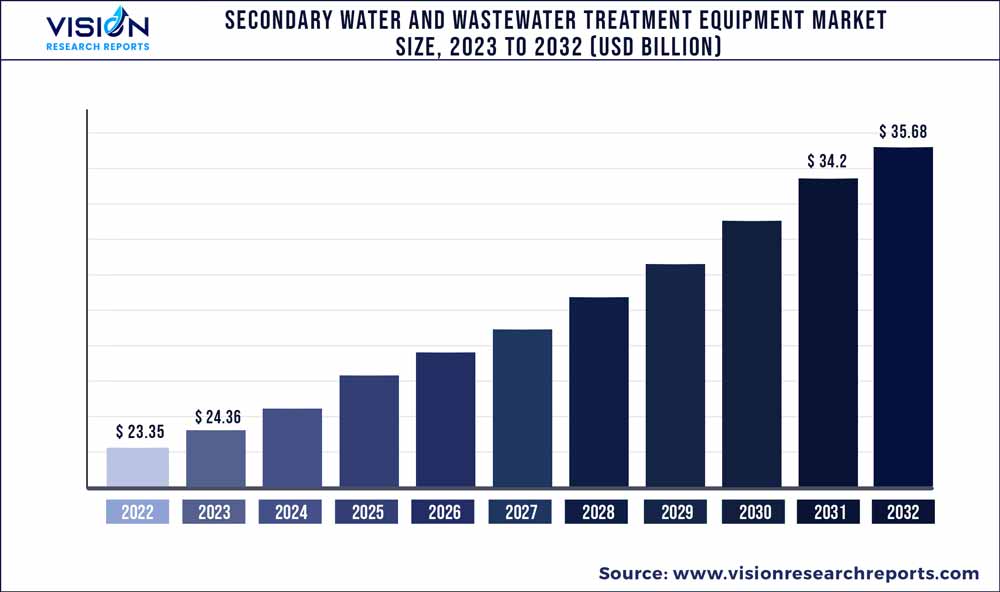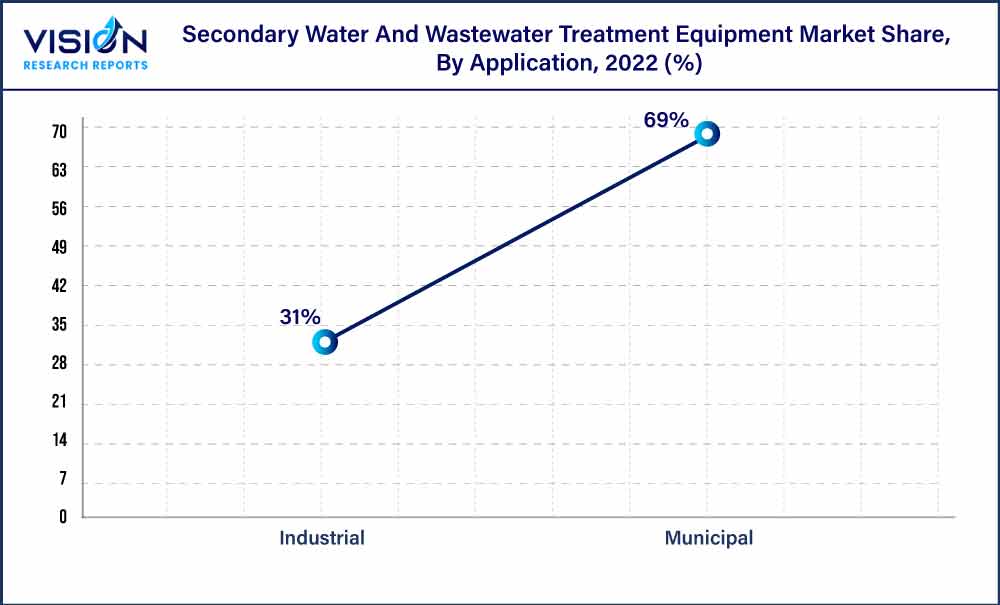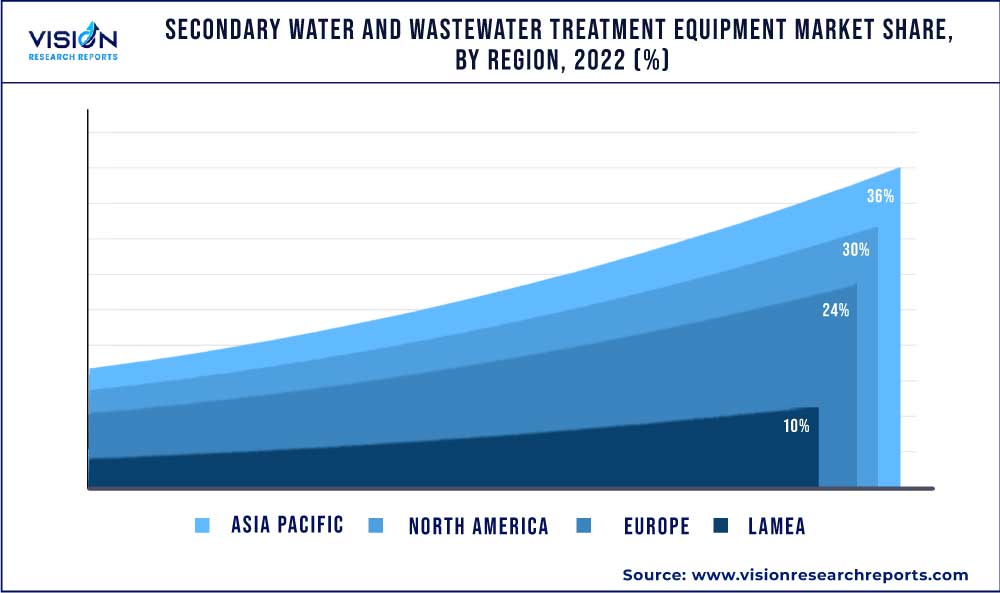The global secondary water and wastewater treatment equipment market size was estimated at around USD 23.35 billion in 2022 and it is projected to hit around USD 35.68 billion by 2032, growing at a CAGR of 4.33% from 2023 to 2032. The secondary water and wastewater treatment equipment market in the United States was accounted for USD 2.6 billion in 2022.

Key Pointers
Report Scope of the Secondary Water And Wastewater Treatment Equipment Market
| Report Coverage | Details |
| Revenue Share of Asia Pacific in 2022 | 36% |
| Revenue Forecast by 2032 | USD 35.68 billion |
| Growth Rate from 2023 to 2032 | CAGR of 4.33% |
| Base Year | 2022 |
| Forecast Period | 2023 to 2032 |
| Market Analysis (Terms Used) | Value (US$ Million/Billion) or (Volume/Units) |
| Companies Covered | Xylem Inc.; Pentair plc; Evoqua Water Technologies LLC; Aquatech International LLC; Ecolab Inc.; Ovivo; Toshiba Water Solutions Private Limited; Veolia; Ecologix Environmental Systems, LLC; Parkson Corporation; Lenntech B.V.; H2O Innovation; Samco Technologies, Inc.; Koch Membrane Systems, Inc. |
Growing demand for wastewater treatment plants coupled with stringent regulations concerning secondary water & wastewater treatment equipment is anticipated to drive the market growth. Secondary treatment is used mainly to remove soluble organic matter and chemicals through the usage of trickling filters, bio-towers, rotating biological contactors, and activated sludge systems. Furthermore, technological incorporation in terms of the development of new methods including moving bed biofilm reactors (MBBR) and integrated fixed film activated sludge (IFAS) for secondary treatment methods is expected to have a strong impact on the market. These aforementioned factors will drive the demand for secondary water & wastewater treatment equipment in the coming years.
The U.S. dominated the North America secondary water & wastewater treatment equipment market in 2022 on account of the developed wastewater treatment infrastructure in the country coupled with stringent effluent regulations. Federal regulations such as the Clean Water Act that establish a regulatory framework for pollutant discharge in water bodies are expected to have a positive impact on market growth in the country.
Secondary treatment typically utilizes biological processes that use bacteria to remove pollutants. The main purpose of secondary wastewater treatment is to remove the suspended and dissolved organic matter from the wastewater to produce an environmentally safe effluent. This treatment consists of microorganisms that are either attached to a media or are in mixed suspension in a basin, where the organic material is broken down and consumed by the microorganisms.
The increased usage of public sewers by rural homes is anticipated to put stress on current centralized wastewater treatment facilities. This is likely to create the need for new capacity development or expansion of existing capacity, which is predicted to boost demand for wastewater secondary treatment equipment over the forecast period. For instance, Evoqua's BioMag system was chosen in January 2020 to enhance the existing secondary treatment capacity of the Bellefonte Borough Authority (BBA) Wastewater Treatment Plant in Pennsylvania, U.S.
A growing population, coupled with rapid urbanization, is anticipated to drive the demand for critical infrastructure, including wastewater treatment plants. In addition, new housing developments, most notably in developing countries, are likely to exert pressure on the existing wastewater treatment infrastructure, thereby driving the need for either capacity expansion of existing plants or the construction of new wastewater treatment plants.
Equipment Insights
The activated sludge segment accounted for a significant market share of 45%, in terms of revenue, in 2022. They are typically found after the wastewater has undergone primary and pre-treatment and before advanced tertiary treatment, which may include chemical, UV disinfection, activated carbon adsorption, sand filtration, and/or anaerobic digestion for the removal of additional pathogens, nutrients, organics, and suspended solids.
The primary objectives of sludge treatment include the removal of hazardous bacteria to lower the health risks for people and surroundings that may come into contact with the material. Additionally, the treatment method helps stabilize some of the organic materials in the sludge, lowering the final volume, often lowering the handling costs, and gathering the products and byproducts of the treatment process.
Other types of equipment used for secondary wastewater treatment include trickling filters, Integrated Fixed-film Activated Sludge (IFAS), Moving Bed Biofilm Reactors (MBBR), rotating biological contactors, and others. MBBR system uses a combination of two processes, namely the activated sludge process and the biofilter process. The system typically consists of aeration tanks that are filled with biofilm carriers, followed by a secondary clarifier system.
Application Insights
The municipal segment led the market and accounted for 69% of the global revenue share in 2022. Factors including rapid urbanization, most notably in emerging economies coupled with rapid housing infrastructural development are anticipated to drive the demand for wastewater treatment plants, which, in turn, is likely to have a positive impact on market growth over the forecast period.

The industrial application segment is anticipated to witness a CAGR of 4.73% over the forecast period. Rapid industrialization in developing countries, coupled with stringent regulations for the disposal of wastewater into the environment from various industries, is anticipated to drive the demand for secondary water and wastewater treatment equipment in the forthcoming years.
Water is utilized in several industrial processes, including manufacturing, power generation, and agriculture, among others. Chemicals and byproducts are often induced in the water as it runs through these processes owing to which industrial wastewater treatment is of utmost importance to remove the bacteria, solids, oil, grease, and other substances before the wastewater is either reused or discharged into the environment.
Regional Insights
Asia Pacific accounted for the largest revenue share of 36% of the global secondary water & wastewater treatment equipment market in 2022. Rapid urbanization, increased investments by governments, and rising consumer spending have boosted the Asian economy, thereby propelling infrastructure development in the construction industry. Emerging economies such as China, India, and Japan are the key countries driving the development of the manufacturing and building & construction industries in this region. The competition among Chinese capital markets and a few other Asian economies is generating lucrative growth opportunities for the industries, which has, in turn, created a favorable environment for investments in the secondary water & wastewater treatment equipment industry.

Several regulations, including the Clean Water Act, recommend that states in the U.S. designate surface waters used for drinking water and set water quality standards. This Act also establishes programs to prevent pollution from entering these waters. Furthermore, the Safe Drinking Water Act (SDWA) mandates the safety of U.S. public drinking water supplies. The presence of these aforementioned regulations in the region aims to provide good-quality water, thereby augmenting the demand for secondary water & wastewater treatment equipment industry.
The Europe region plays a crucial role in the global market for water and wastewater treatment equipment. Rapid technological advancements in the region to gain market dominance and maintain competitiveness are likely to boost market growth. Stringent government regulations, industrial automation, top mergers & acquisitions, strategic policies, and expansions have propelled the secondary water & wastewater treatment equipment industry’s growth.
Secondary Water And Wastewater Treatment Equipment Market Segmentations:
By Equipment
By Application
By Region
Chapter 1. Introduction
1.1. Research Objective
1.2. Scope of the Study
1.3. Definition
Chapter 2. Research Methodology
2.1. Research Approach
2.2. Data Sources
2.3. Assumptions & Limitations
Chapter 3. Executive Summary
3.1. Market Snapshot
Chapter 4. Market Variables and Scope
4.1. Introduction
4.2. Market Classification and Scope
4.3. Industry Value Chain Analysis
4.3.1. Raw Material Procurement Analysis
4.3.2. Sales and Distribution Channel Analysis
4.3.3. Downstream Buyer Analysis
Chapter 5. COVID 19 Impact on Secondary Water And Wastewater Treatment Equipment Market
5.1. COVID-19 Landscape: Secondary Water And Wastewater Treatment Equipment Industry Impact
5.2. COVID 19 - Impact Assessment for the Industry
5.3. COVID 19 Impact: Global Major Government Policy
5.4. Market Trends and Opportunities in the COVID-19 Landscape
Chapter 6. Market Dynamics Analysis and Trends
6.1. Market Dynamics
6.1.1. Market Drivers
6.1.2. Market Restraints
6.1.3. Market Opportunities
6.2. Porter’s Five Forces Analysis
6.2.1. Bargaining power of suppliers
6.2.2. Bargaining power of buyers
6.2.3. Threat of substitute
6.2.4. Threat of new entrants
6.2.5. Degree of competition
Chapter 7. Competitive Landscape
7.1.1. Company Market Share/Positioning Analysis
7.1.2. Key Strategies Adopted by Players
7.1.3. Vendor Landscape
7.1.3.1. List of Suppliers
7.1.3.2. List of Buyers
Chapter 8. Global Secondary Water And Wastewater Treatment Equipment Market, By Equipment
8.1. Secondary Water And Wastewater Treatment Equipment Market, by Equipment, 2023-2032
8.1.1. Activated Sludge
8.1.1.1. Market Revenue and Forecast (2020-2032)
8.1.2. Sludge Treatment
8.1.2.1. Market Revenue and Forecast (2020-2032)
8.1.3. Others
8.1.3.1. Market Revenue and Forecast (2020-2032)
Chapter 9. Global Secondary Water And Wastewater Treatment Equipment Market, By Application
9.1. Secondary Water And Wastewater Treatment Equipment Market, by Application, 2023-2032
9.1.1. Municipal
9.1.1.1. Market Revenue and Forecast (2020-2032)
9.1.2. Industrial
9.1.2.1. Market Revenue and Forecast (2020-2032)
Chapter 10. Global Secondary Water And Wastewater Treatment Equipment Market, Regional Estimates and Trend Forecast
10.1. North America
10.1.1. Market Revenue and Forecast, by Equipment (2020-2032)
10.1.2. Market Revenue and Forecast, by Application (2020-2032)
10.1.3. U.S.
10.1.3.1. Market Revenue and Forecast, by Equipment (2020-2032)
10.1.3.2. Market Revenue and Forecast, by Application (2020-2032)
10.1.4. Rest of North America
10.1.4.1. Market Revenue and Forecast, by Equipment (2020-2032)
10.1.4.2. Market Revenue and Forecast, by Application (2020-2032)
10.2. Europe
10.2.1. Market Revenue and Forecast, by Equipment (2020-2032)
10.2.2. Market Revenue and Forecast, by Application (2020-2032)
10.2.3. UK
10.2.3.1. Market Revenue and Forecast, by Equipment (2020-2032)
10.2.3.2. Market Revenue and Forecast, by Application (2020-2032)
10.2.4. Germany
10.2.4.1. Market Revenue and Forecast, by Equipment (2020-2032)
10.2.4.2. Market Revenue and Forecast, by Application (2020-2032)
10.2.5. France
10.2.5.1. Market Revenue and Forecast, by Equipment (2020-2032)
10.2.5.2. Market Revenue and Forecast, by Application (2020-2032)
10.2.6. Rest of Europe
10.2.6.1. Market Revenue and Forecast, by Equipment (2020-2032)
10.2.6.2. Market Revenue and Forecast, by Application (2020-2032)
10.3. APAC
10.3.1. Market Revenue and Forecast, by Equipment (2020-2032)
10.3.2. Market Revenue and Forecast, by Application (2020-2032)
10.3.3. India
10.3.3.1. Market Revenue and Forecast, by Equipment (2020-2032)
10.3.3.2. Market Revenue and Forecast, by Application (2020-2032)
10.3.4. China
10.3.4.1. Market Revenue and Forecast, by Equipment (2020-2032)
10.3.4.2. Market Revenue and Forecast, by Application (2020-2032)
10.3.5. Japan
10.3.5.1. Market Revenue and Forecast, by Equipment (2020-2032)
10.3.5.2. Market Revenue and Forecast, by Application (2020-2032)
10.3.6. Rest of APAC
10.3.6.1. Market Revenue and Forecast, by Equipment (2020-2032)
10.3.6.2. Market Revenue and Forecast, by Application (2020-2032)
10.4. MEA
10.4.1. Market Revenue and Forecast, by Equipment (2020-2032)
10.4.2. Market Revenue and Forecast, by Application (2020-2032)
10.4.3. GCC
10.4.3.1. Market Revenue and Forecast, by Equipment (2020-2032)
10.4.3.2. Market Revenue and Forecast, by Application (2020-2032)
10.4.4. North Africa
10.4.4.1. Market Revenue and Forecast, by Equipment (2020-2032)
10.4.4.2. Market Revenue and Forecast, by Application (2020-2032)
10.4.5. South Africa
10.4.5.1. Market Revenue and Forecast, by Equipment (2020-2032)
10.4.5.2. Market Revenue and Forecast, by Application (2020-2032)
10.4.6. Rest of MEA
10.4.6.1. Market Revenue and Forecast, by Equipment (2020-2032)
10.4.6.2. Market Revenue and Forecast, by Application (2020-2032)
10.5. Latin America
10.5.1. Market Revenue and Forecast, by Equipment (2020-2032)
10.5.2. Market Revenue and Forecast, by Application (2020-2032)
10.5.3. Brazil
10.5.3.1. Market Revenue and Forecast, by Equipment (2020-2032)
10.5.3.2. Market Revenue and Forecast, by Application (2020-2032)
10.5.4. Rest of LATAM
10.5.4.1. Market Revenue and Forecast, by Equipment (2020-2032)
10.5.4.2. Market Revenue and Forecast, by Application (2020-2032)
Chapter 11. Company Profiles
11.1. Xylem Inc.
11.1.1. Company Overview
11.1.2. Product Offerings
11.1.3. Financial Performance
11.1.4. Recent Initiatives
11.2. Pentair plc
11.2.1. Company Overview
11.2.2. Product Offerings
11.2.3. Financial Performance
11.2.4. Recent Initiatives
11.3. Evoqua Water Technologies LLC
11.3.1. Company Overview
11.3.2. Product Offerings
11.3.3. Financial Performance
11.3.4. Recent Initiatives
11.4. Aquatech International LLC
11.4.1. Company Overview
11.4.2. Product Offerings
11.4.3. Financial Performance
11.4.4. LTE Scientific
11.5. Ecolab Inc.
11.5.1. Company Overview
11.5.2. Product Offerings
11.5.3. Financial Performance
11.5.4. Recent Initiatives
11.6. Ovivo
11.6.1. Company Overview
11.6.2. Product Offerings
11.6.3. Financial Performance
11.6.4. Recent Initiatives
11.7. Toshiba Water Solutions Private Limited
11.7.1. Company Overview
11.7.2. Product Offerings
11.7.3. Financial Performance
11.7.4. Recent Initiatives
11.8. Veolia
11.8.1. Company Overview
11.8.2. Product Offerings
11.8.3. Financial Performance
11.8.4. Recent Initiatives
11.9. Ecologix Environmental Systems, LLC
11.9.1. Company Overview
11.9.2. Product Offerings
11.9.3. Financial Performance
11.9.4. Recent Initiatives
11.10. Parkson Corporation
11.10.1. Company Overview
11.10.2. Product Offerings
11.10.3. Financial Performance
11.10.4. Recent Initiatives
Chapter 12. Research Methodology
12.1. Primary Research
12.2. Secondary Research
12.3. Assumptions
Chapter 13. Appendix
13.1. About Us
13.2. Glossary of Terms
 Cross-segment Market Size and Analysis for
Mentioned Segments
Cross-segment Market Size and Analysis for
Mentioned Segments
 Additional Company Profiles (Upto 5 With No Cost)
Additional Company Profiles (Upto 5 With No Cost)
 Additional Countries (Apart From Mentioned Countries)
Additional Countries (Apart From Mentioned Countries)
 Country/Region-specific Report
Country/Region-specific Report
 Go To Market Strategy
Go To Market Strategy
 Region Specific Market Dynamics
Region Specific Market Dynamics Region Level Market Share
Region Level Market Share Import Export Analysis
Import Export Analysis Production Analysis
Production Analysis Others
Others